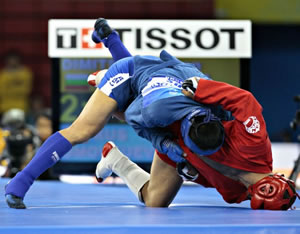Difference between Sambo and Judo
Key difference: A lucid disparity between Sambo and Judo is that the former originated in Russia, whereas the latter originated in Japan.
 Sambo is an acronym for SAMozashchita Bez Oruzhiya, which is the Russian for “self-defense without weapons”. Played as a combat sport across the world and in Russia, its country of origin, Sambo is also a form of martial art. It was devised in the first half of the 1920’s by the Soviet Red Army, in order to enrich their hand-to-hand combat techniques. Sambo is influenced by other forms of martial arts as well, such as Wrestling, Judo, Folk style wrestling, etc. Sambo gained recognition in the year 1938, when it was declared an official sport by the USSR All-Union Sports Committee. Although it isn’t an Olympic sport, Sambo has its fair share of supporters for this cause and a decent fan following as well.
Sambo is an acronym for SAMozashchita Bez Oruzhiya, which is the Russian for “self-defense without weapons”. Played as a combat sport across the world and in Russia, its country of origin, Sambo is also a form of martial art. It was devised in the first half of the 1920’s by the Soviet Red Army, in order to enrich their hand-to-hand combat techniques. Sambo is influenced by other forms of martial arts as well, such as Wrestling, Judo, Folk style wrestling, etc. Sambo gained recognition in the year 1938, when it was declared an official sport by the USSR All-Union Sports Committee. Although it isn’t an Olympic sport, Sambo has its fair share of supporters for this cause and a decent fan following as well.
The sport is regulated by its apex authority, which is the FIAS (The International Federation of Amateur Sambo). Basically, there are three main styles of Sambo at present. The first is called as Sport Sambo, which is pretty much alike Olympic Freestyle Wrestling or Judo. Combat Sambo is the second variant of Sambo. This type was developed for the military. This form is exactly similar to the modern MMA, i.e. the Mixed Martial Arts. The third and the final format of Sambo is known as Freestyle Sambo. This format was developed by the ASA (American Sambo Association) in 2004. Though it doesn’t permit striking, but choke holds and other forms of submission are allowed in Freestyle Sambo.
.jpg) Judo is another dynamic form of martial arts that originated in Japan. It was developed by Jigoro Kano in the year 1882. At the time of its origin, Judo was limited to being a sport, but as of the 20thcentury and the new millennium, Judo gained recognition as an Olympic sport, and a martial art form as well. The practitioners of Judo, i.e. those who undertake its training, are known as Judoka, while a Judo instructor is called as a Sensei. The Judokas have to dress in traditional Japanese attire known as keikogi, while performing or practicing Judo. A keikogi is basically a kimono, which comes fastened by a colored belt.
Judo is another dynamic form of martial arts that originated in Japan. It was developed by Jigoro Kano in the year 1882. At the time of its origin, Judo was limited to being a sport, but as of the 20thcentury and the new millennium, Judo gained recognition as an Olympic sport, and a martial art form as well. The practitioners of Judo, i.e. those who undertake its training, are known as Judoka, while a Judo instructor is called as a Sensei. The Judokas have to dress in traditional Japanese attire known as keikogi, while performing or practicing Judo. A keikogi is basically a kimono, which comes fastened by a colored belt.
Famous for its grappling and throwing techniques, Judo is practiced and taught as an art form in many countries of the world. The fundamental objective of Judo is to throw or takedown one’s opponent to the ground. For doing this, landing a series of strikes and thrusts on the opponent, by using one’s hands and feet is allowed in Judo. A participant is declared a winner only when his/her opponent is immobilized on the ground with a pin, or by using a joint lock or a choking technique. In Olympics, the participants have to observe strict adherence to the rules and regulations of this sport. Regular and appropriate penalties are attracted by participants who use illegal moves and space outside the designated area, to takedown and pin an opponent to the ground.
Comparison between Sambo and Judo:
|
|
Sambo |
Judo |
|
Meaning |
“Self-defense without weapons” |
"Gentle way" |
|
Country of origin |
Russia |
Japan |
|
Time of Origin |
Early 1920’s |
1882 |
|
Founder |
Said to be Anatoly Kharlampiev |
Jigoro Kano |
|
Focus |
Hybrid techniques of fighting |
Grappling |
|
Olympic Sport |
No |
Yes |
|
Apex authority |
FIAS (The International Federation of Amateur Sambo) |
IJF (International Judo Federation) |
|
Types |
Three: Sport Sambo, Combat Sambo and Freestyle Sambo |
Brazilian Jiu-Jitsu, Kosen Judo, Russian Judo, and also Sport Sambo. |
Image Courtesy: prezi.com, newbreedjiujitsu.com









Add new comment